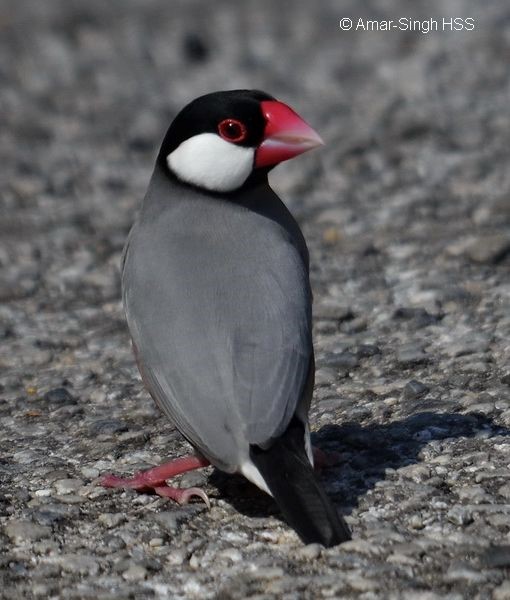Birdfinding.info ⇒ Declining and now uncommon and localized on Java and Bali, but numerous and increasing in Hawaii, where it is locally abundant in the lowlands of Oahu, Kauai, Maui, and the Big Island. On Oahu it is common in Honolulu city parks (e.g., Kapiolani, Fort DeRussy, and Wawamalu) and at Ko Olina Beach, Pearl Harbor, James Campbell National Wildlife Refuge; on Maui, anywhere along the western coastal strips (e.g., Kaanapali, Kihei, and Wailea); on the Big Island, in Kailua-Kona, Kahaluu-Keauhou, and Hilo; and on Kauai, in several coastal towns (e.g., Princeville, Lihue, Eleele, Hanapepe, and Waimea). In Puerto Rico, most sightings are in Old San Juan and adjacent Miramar. In the Philippines, consistent sites on Luzon include Laoang City, Bugallon, and Los Baños, and on Quezon near General Santos City at Kantagawan.
Java Sparrow
Lonchura oryzivora
Native to Java, Bali, and Madura; widely introduced elsewhere. Has declined dramatically in its natural range, to such an extant that IUCN designated it as endangered in 2018. Introduced populations now greatly exceed native ones.
Typically lives in association with humans, in urban and agricultural habitats, often nesting in the eaves of buildings—most famously in Buddhist temples.
When not breeding, forms large flocks, sometimes exceeding 1,000 birds, that wander locally in search of grain crops.

Java Sparrow. (Fort DeRussy Beach Park, Honolulu, Hawaii; December 17, 2017.) © Derek Stokes
Widely introduced across eastern Asia and the Pacific, and locally elsewhere, but many historically stable introduced populations have declined or disappeared in recent decades. Introduced populations in China date back to the Ming Dynasty, which ended in the 1600s.
The largest known populations are in Hawaii and the Philippines. In Hawaii it is widespread on all the main islands, particularly Oahu, where it apparently became established in the late 1960s on Oahu, then spread to Kauai, Molokai, Maui, the Big Island, and Lanai (since 2009). In the Philippines, it is well established in the north (western and central Luzon) and the south (western and southern Quezon), with smaller numbers on some of the middle islands, especially Negros.
Localized populations appear to be well-established in: peninsular Malaysia (mainly Perlis and Ipoh); Borneo (mainly in coastal areas of Sabah, Brunei, and West Kalimantan); Sulawesi (northeast and southwest); the Lesser Sundas (Sumbawa, Flores, and Sumba); Australia’s Christmas Island, Puerto Rico (San Juan), and St. Helena.
Additional locations where it seems more tenuously established include: Bangkok; Guam; Fiji; Tanzania’s Pemba Island; and Cali, Colombia.
Its current status in much of eastern Asia is unclear. It was formerly regarded as established in coastal eastern China from Jiangsu to Hong Kong, southern Honshu, Kyushu, Taiwan, southern Vietnam, and Singapore.
Other areas where small introduced populations once appeared established, but then vanished, include: Colombo, Sri Lanka; Kolkata and Madras, India; Tenasserim, Myanmar; several Indonesian islands (Bawean, Lombok, and, among others); Mauritius; the Comoros; the Caroline Islands; and Miami, Florida.
Identification
Distinctive: a mostly-gray finch with a dull-cinnamon belly, an outsized, puffin-like, rosy bill, and bulging white cheek-patches on an otherwise black head.
The closely related Timor Sparrow (no range overlap) has the same head pattern but otherwise different coloration (mostly brown with a gray bill).
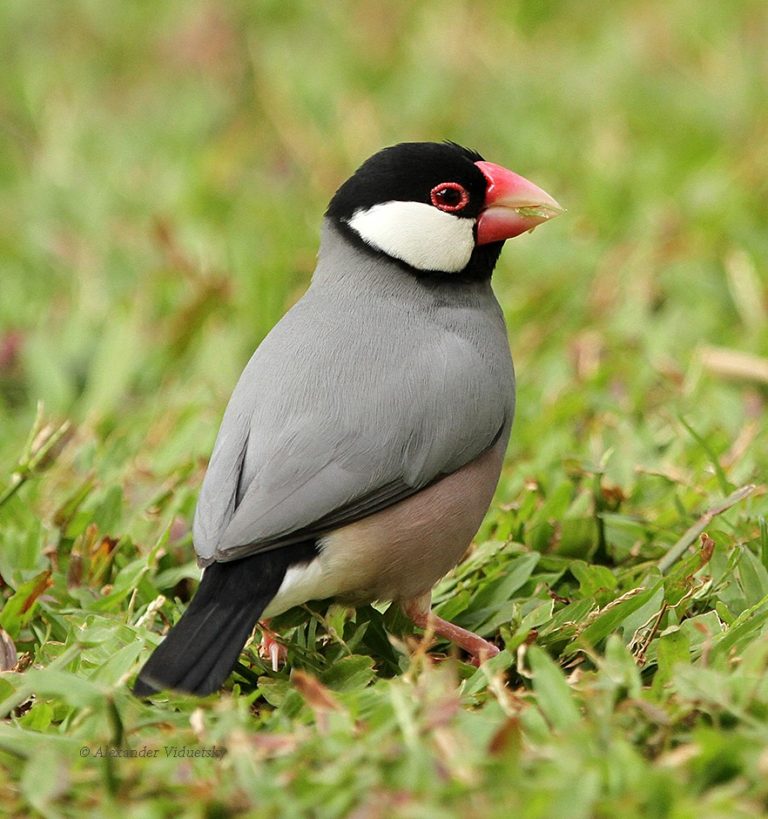
Java Sparrow. (Waikiki, Oahu, Hawaii; October 14, 2011.) © Alexander Viduetsky

Java Sparrow. (Kapiolani Park, Honolulu, Hawaii; February 2, 2013.) © Matthew Grube
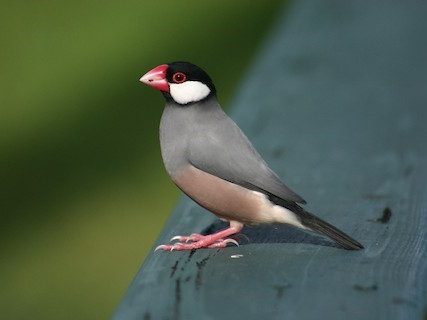
Java Sparrow. (Honolulu, Hawaii; June 21, 2007.) © David Clark
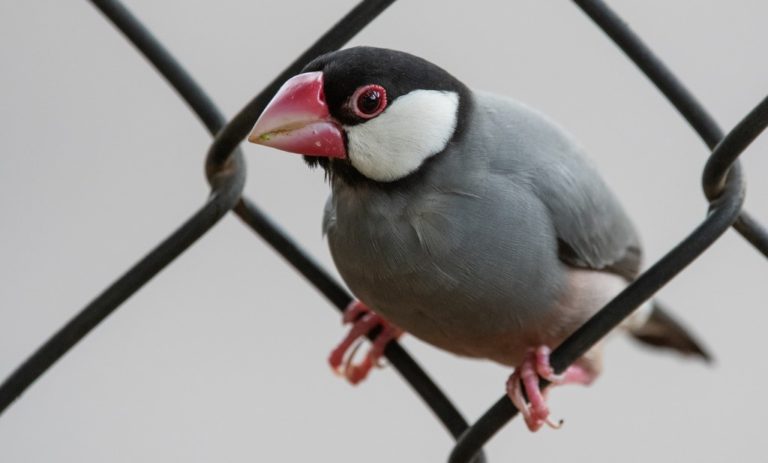
Java Sparrow. (Kaanapali, Maui, Hawaii; December 20, 2019.) © Mason Maron

Java Sparrow, showing bulging white cheeks and mid-breast boundary between gray and cinnamon feathers. (Chake Chake, Pemba, Tanzania; December 27, 2014.) © Lars Petersson
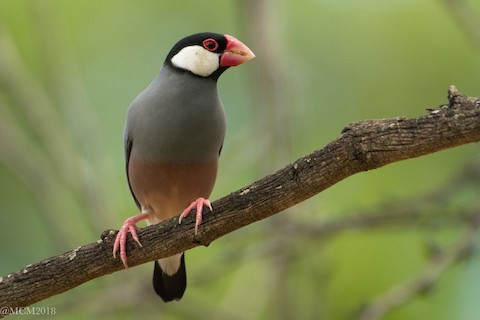
Java Sparrow, ventral view. (Pearl Harbor National Wildlife Refuge, Oahu, Hawaii; October 7, 2018.) © Mary Catherine Miguez
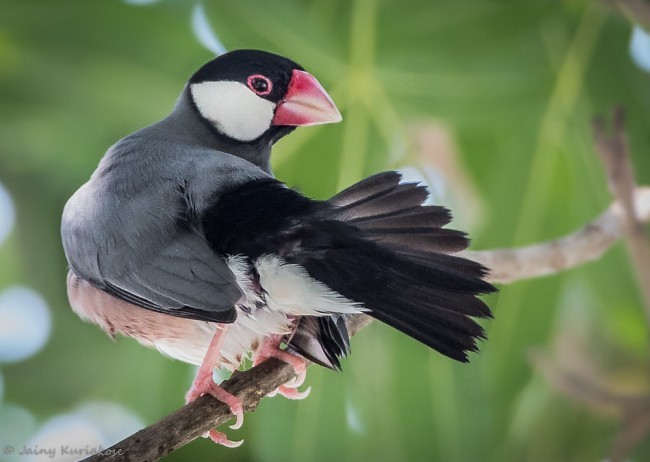
Java Sparrow, with tail fanned. (Bangkok, Thailand; October 12, 2013.) © Jainy Kuriakose

Java Sparrow, showing bulging white cheeks. (Kapiolani Park, Honolulu, Oahu, Hawaii; September 10, 2018.) © Bradley Hacker
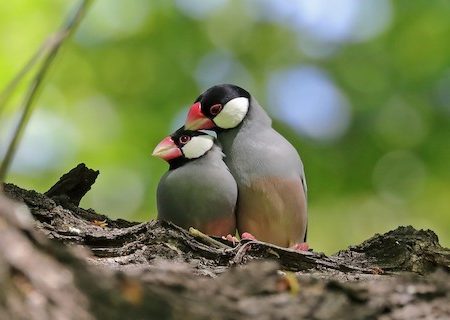
Java Sparrow, pair bonding. (Kuhio Beach Park, Waikiki, Honolulu, Hawaii; July 25, 2017.) © Doug Hommet
Juveniles are ash-gray overall with a black bill. As they progress through successive immature stages, the bill turns pink and the underparts and head turn whitish, then the adult pattern emerges.
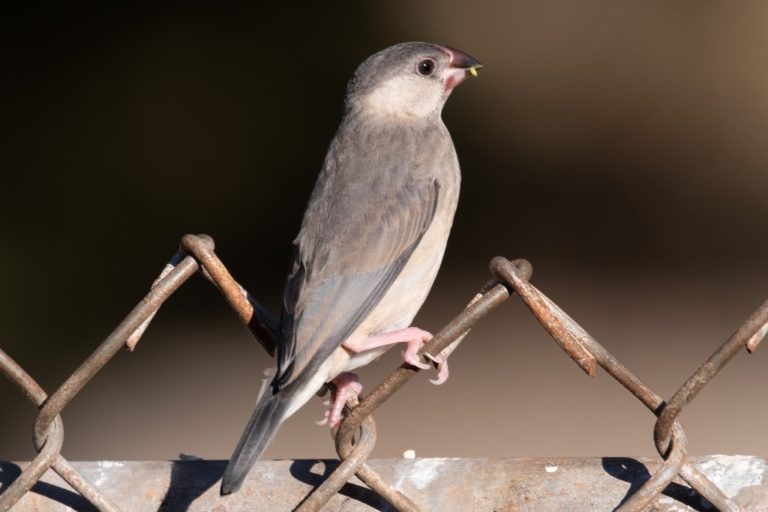
Java Sparrow, immature with bill beginning to turn from black to pink. (Napili-Honokowai, Maui, Hawaii; December 15, 2019.) © Mason Maron
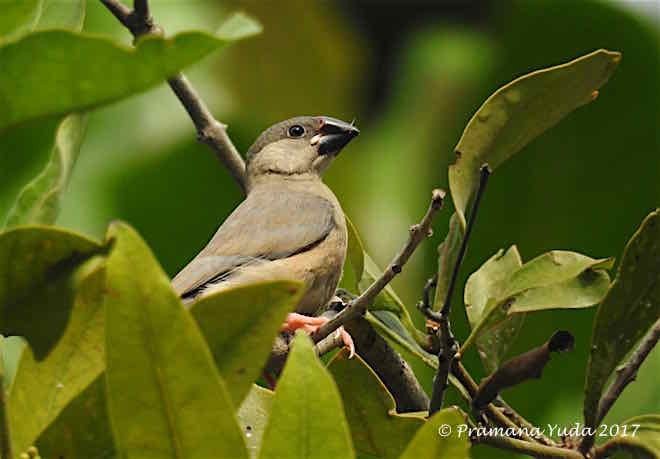
Java Sparrow, immature with all-black bill and atypically buffy body coloration. (Gadjah Mada University, Yogyakarta, Java, Indonesia; September 27, 2017.) © Pramana Yuda
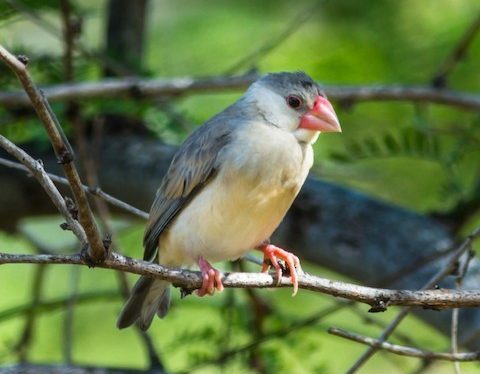
Java Sparrow, immature beginning to molt into adult plumage and showing atypical yellowish patches on breast and vent. (Diamond Head Crater Park, Oahu, Hawaii; December 24, 2018.) © Jim Merritt
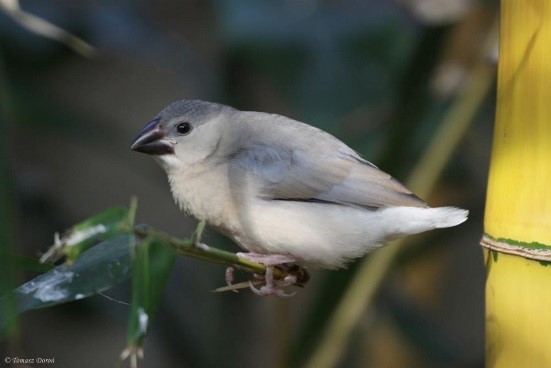
Java Sparrow, recently fledged juvenile showing all-black bill. (Vogelpark Avifauna, Netherlands; April 18, 2013.) © Tomasz Doron
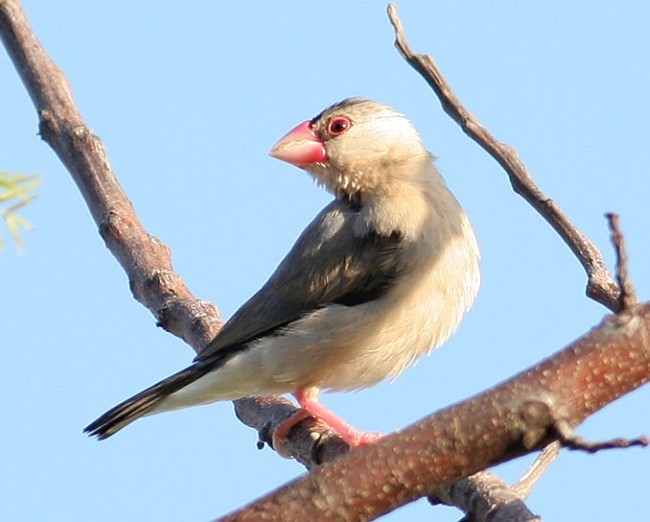
Java Sparrow, immature with pink bill and typical body coloration. (Christmas Island, Australia; August 31, 2007.) © Cherry Wong
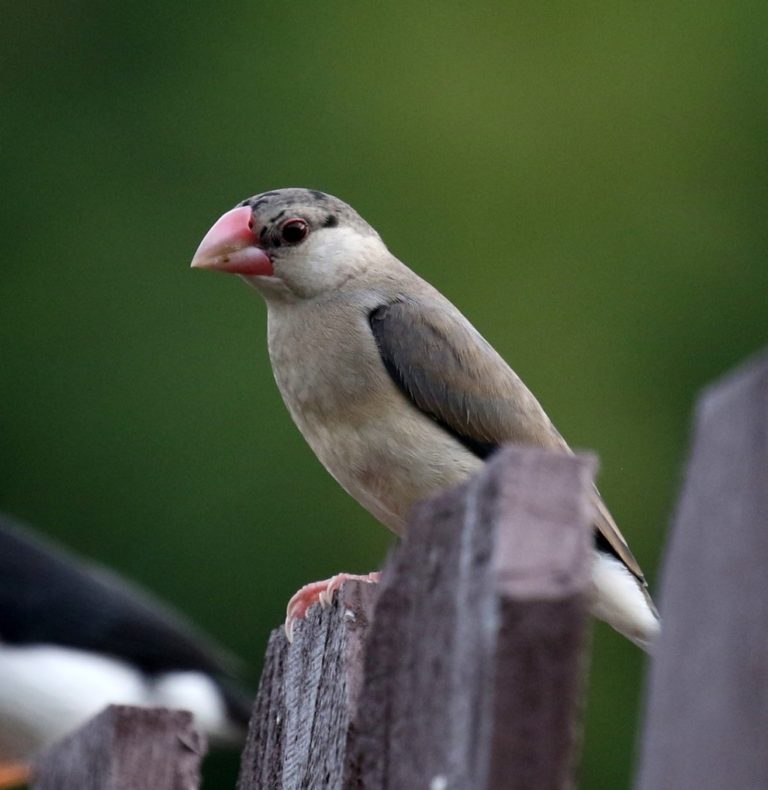
Java Sparrow, immature molting into adult plumage. (Kahaluu-Keauhou, Big Island, Hawaii; January 15, 2020.) © Robin Gwen Agarwal
Voice. The song is described as “a series of bell-like notes followed by trilling and clucking sounds, often ending with a long, drawn-out, metallic whistling note.” (Clement et al. 1993)
Notes
Monotypic species.
IUCN Red List Status: Endangered.
References
BirdLife International. 2018. Lonchura oryzivora. The IUCN Red List of Threatened Species 2018: e.T22719912A131809903. https://dx.doi.org/10.2305/IUCN.UK.2018-2.RLTS.T22719912A131809903.en. (Accessed March 29, 2020.)
Brazil, M. 2009. Birds of East Asia. Princeton University Press, Princeton, N.J.
Clement, P., A. Harris, and J. Davis. 1993. Finches and Sparrows: An Identification Guide. Princeton University Press, Princeton, N.J.
eBird. 2020. eBird: An online database of bird distribution and abundance. Cornell Lab of Ornithology, Ithaca, N.Y. http://www.ebird.org. (Accessed March 29, 2020.)
Hawaii Audubon Society. 2005. Hawaii’s Birds (Sixth Edition). Island Heritage Publishing, Waipahu, Hawaii.
Islam, K. 1997. Java Sparrow (Lonchura oryzivora), version 2.0. In The Birds of North America (A.F. Poole and F.B. Gill, eds.). Cornell Lab of Ornithology, Ithaca, N.Y. https://doi.org/10.2173/bna.304.
Kirwan, G.M., A. Levesque, M. Oberle, and C.J. Sharpe. 2019. Birds of the West Indies. Lynx Edicions, Barcelona.
National Institute for Environmental Studies, Invasive Species of Japan, Lonchura atricapilla. https://www.nies.go.jp/biodiversity/invasive/DB/detail/20220e.html. (Accessed April 15, 2018.)
Payne, R., and C.J. Sharpe. 2020. Java Sparrow (Lonchura oryzivora). In: del Hoyo, J., Elliott, A., Sargatal, J., Christie, D.A. & de Juana, E. (eds.). Handbook of the Birds of the World Alive. Lynx Edicions, Barcelona. https://www.hbw.com/node/61184. (Accessed March 29, 2020.)
Pratt, H.D. 1993. Enjoying Birds in Hawaii: A Birdfinding Guide to the Fiftieth State (Second Edition). Mutual Publishing, Honolulu, Hawaii.
Pyle, R.L., and P. Pyle. 2017. The Birds of the Hawaiian Islands: Occurrence, History, Distribution, and Status. Version 2. B.P. Bishop Museum, Honolulu, Hawaii. http://hbs.bishopmuseum.org/birds/rlp-monograph/.
Raffaele, H., J. Wiley, O. Garrido, A. Keith, and J. Raffaele. 1998. A Guide to the Birds of the West Indies. Princeton University Press, Princeton, N.J.
Restall, R. 1997. Munias and Mannakins. Yale University Press, New Haven.
